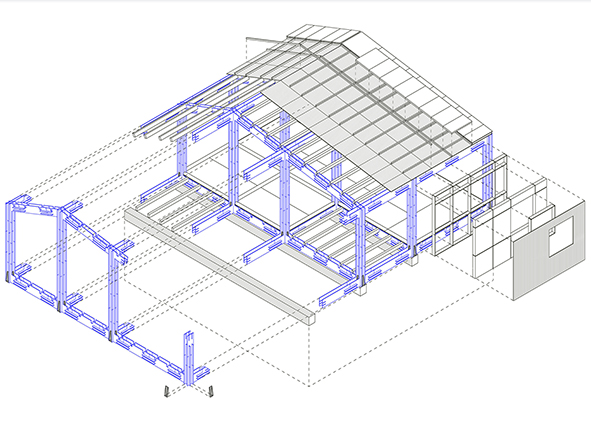Temporary city between emergency and recovery
DOI:
https://doi.org/10.19229/2464-9309/4182018Keywords:
living, building system, emergency, discomfort, temporarinessAbstract
The housing emergency resulting from earthquakes or other natural disasters generally finds an initial response in temporary structures such as prefabricated houses and/or containers. The chronicles of recent and less recent disastrous events show how such structures – inadequate to implement an acceptable living quality, thought and designed as ‘emergency’ solutions – remain in place for a long time, which can also occupy the space of some decades, waiting for the reconstruction. Although the resulting housing disadvantage is enormous, the current management policies in the field of post-disaster emergency do not seem to have dealt with this transitional phase in an organic way. The paper presents the first results of a scientific-design research carried out at the School of Architecture and Design Eduardo Vittoria of Ascoli Piceno (SAAD) of the University of Camerino concerning the transformation of post-disaster first emergency settlements into temporary urban systems capable of reactivating social and productive dynamics.
Downloads
Article Metrics Graph
References
Amendola, G. and Tosi, A. (eds) (1987), “La sociologia della abitazione”, numero monografico di Sociologia e ricerca Sociale, n. 22.
Angelucci, F. (2003), “Abitare in emergenza”, in Costruire, n. 246, pp. 42-54.
Banham, R. (1965), “Un’architettura a clip”, in Biraghi, M. (ed.), Architettura della seconda età della macchina, Electa, Milano.
Bologna, R. and Terpolilli, C. (eds) (2005), Emergenza del progetto – Progetto dell’emergenza, Architettura con-temporanea, 24 Ore Cultura, Milano.
Cavallari, L. (ed.) (2003), Abitare e costruire in emergenza, Sala Editori, Pescara.
de Certeau, M. (2001), L’invenzione del quotidiano [orig. ed. L’Invention du quotidien, 1990], Edizioni Lavoro, Roma.
Falasca, C. (2000), Architetture ad assetto variabile, Alinea, Firenze.
Friedman, Y. (1978), L’architettura della sopravvivenza, Quodlibet, Macerata.
Giachetta, A. (2004), Architettura e tempo – La variabile della durata nel progetto di architettura, Libreria CLUP, Milano.
Giuliani, M. V. (2004), “Teoria dell’attaccamento ai luoghi”, in Bonaiuto, M., Bonnes, M. and Lee, T. (eds), Teorie in pratica per la ricerca ambientale, Raffaello Editore, Milano, pp. 190-202.
Guiducci, R. (1975), La città dei cittadini, Rizzoli, Milano.
Habraken, N. J. (1972), Supports – An Alternative to Mass Housing [orig. ed. De dragers en de mensen: Het einde van de massawoningbouw, 1961], The Architectural Press, London.
La Cecla, F, (2000), Perdersi – L’uomo senza ambiente, Laterza, Bari.
Marchetti, C. Solimano, N. and Tosi, A. (eds) (2000), Le culture dell’abitare | Living in city and urban cultures, Polistampa, Firenze.
Marrone, V. (2013), L’abitare come relazione sociale – Il significato della casa e i processi di coesione sociale di vicinato, Tesi di Dottorato di Ricerca in Sociologia, Università di Bologna.
Mattioli, L. (2011), Abitare? Emergenza, Aracne editrice, Roma.
Norberg-Schulz, C. (1995), L’abitare – L’insediamento, lo spazio urbano, la casa, Electa, Milano.
Obrist, H. U. (2011), Cedric Price – Re: CP, Lettera Ventidue, Siracusa.
Palazzotto, E. (ed.) (2003), Abitare la temporaneità – L’architettura della casa e della città, L’Epos, Palermo.
Perriccioli, M. (2016), “Piccola scala per grande dimensione – Sistemi di micro-architetture per la città temporanea di Civitanova Marche”, in Techne, n. 12, pp. 174-181.
Perriccioli, M. (2006), La temporaneità oltre l’emergenza – Strategie insediative per l’abitare temporaneo, Edizioni Kappa, Bologna.
Perriccioli, M. (2004), Costruire, Abitare, Tempo, Libreria Clup, Milano.
Platt-So, E. (2017), “Speed or deliberation: a comparison of post-disaster recovery in Japan, Turkey, and Chile”, in Disaster, vol. 41, issue 4, pp. 694-727.
Rametta, G. (2017), “Temporaneità”, in Filosofia e Politica, n. 1, pp. 81-92.
Twigger Ross, M. and Breakwell, G. (2004), “Teorie dell’identità e psicologia ambientale”, in Bonnes, M., Bonaiuto, M. and Lee, T. (eds), Teorie in pratica per la ricerca ambientale, Raffaello Cortina, Milano.
Zanelli, A. (2003), Trasportabile/Trasformabile, Clup, Milano.
Zolli, A. and Healy, A. M. (2014), Resilienza – La scienza di adattarsi ai cambiamenti, Rizzoli, Milano.

Downloads
Published
How to Cite
Issue
Section
License
This Journal is published under Creative Commons Attribution Licence 4.0 (CC-BY).
License scheme | Legal code
This License allows anyone to:
Share: copy and redistribute the material in any medium or format.
Adapt: remix, transform, and build upon the material for any purpose, even commercially.
Under the following terms
Attribution: Users must give appropriate credit, provide a link to the license, and indicate if changes were made; users may do so in any reasonable manner, but not in any way that suggests the licensor endorses them or their use.
No additional restrictions: Users may not apply legal terms or technological measures that legally restrict others from doing anything the license permits.
Notices
Users do not have to comply with the license for elements of the material in the public domain or where your use is permitted by an applicable exception or limitation.
No warranties are given. The license may not give users all of the permissions necessary for their intended use. For example, other rights such as publicity, privacy, or moral rights may limit how you use the material.


















































































